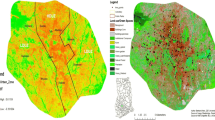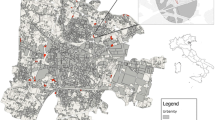Abstract
Urban parks constitute critical biodiversity hotspots in crowded, concrete-dominated city environments. Despite the importance, they remain little researched. This paper assesses the biodiversity and distribution of trees in urban parks in the southern Indian city of Bangalore. 127 plots were used to survey tree distribution in parks across the city. The distribution is largely dominated by a few common species. The proportion of exotic species was very high, with 77% of trees belonging to introduced species. Park history had an impact on distribution. Old parks had fewer but larger trees, and greater species diversity compared to recently established parks. Old parks also differed in species composition, having a greater proportion of large canopy trees compared to young parks. Examination of size distributions revealed that large canopied species were gradually being phased out, and replaced by narrow and medium sized tree species which are easier to maintain, but which may not provide the same environmental and ecological benefits. Greater attention requires to be paid to the selection of trees in cities, not just with a view to easy maintenance as is currently the case, but to select an appropriate mix of trees that supports biodiversity and maximizes environmental and ecosystem services.




Similar content being viewed by others
References
Alvey AA (2006) Promoting and preserving biodiversity in the urban forest. Urban For Urban Green 5:195–201
Aminzadeh B, Khansefid M (2010) A case study of urban ecological networks and a sustainable city: Tehran’s metropolitan area. Urban Ecosyst. doi:10.1007/s11252-009-0101-3
Bolund P, Hunhammar S (1999) Ecosystem services in urban areas. Ecol Econ 29:293–301
Botkin DB, Beveridge CE (1997) Cities as environments. Urban Ecosyst 1:3–19
Chaudhry P, Tewari VP (2010) Managing urban parks and gardens in developing countries: a case from Chandigarh India. Int J Leisure Tourism Market 1:248–256
Chiesura A (2004) The role of urban parks for the sustainable city. Landsc Urban Plan 68:129–138
Clarke KM, Fisher BL, LeBuhn G (2008) The influence of urban park characteristics on ant (Hymenoptera, Formicidae) communities. Urban Ecosyst 11:317–334
Cornelis J, Hermy M (2004) Biodiversity relationships in urban and suburban parks in Flanders. Landsc Urban Plan 69:385–401
Davies RG, Barbosa O, Fuller RA, Tratalos J, Burke N, Lewis D, Warren PH, Gaston KJ (2008) City-wide relationships between green spaces, urban land use and topography. Urban Ecosyst 11:269–287
Dos Santos AR, da Rocha CF, Bergallo HG (2010) Native and exotic species in the urban landscape of the city of Rio di Janeiro, Brazil: density, richness and arboreal deficit. Urban Ecosyst. doi:10.1007/s11252-009-0113-z
Fernández-Juricic E, Jokimäki J (2001) A habitat island approach to conserving birds in urban landscapes: case studies from southern and northern Europe. Biodivers Conserv 10:2023–2043
Freestone R, Nichols D (2004) Realising new leisure opportunities for old urban parks: the internal reserve in Australia. Landsc Urban Plan 68:109–120
Garcillán P, Rebman J, Casillas F (2009) Analysis of the non-native flora of Ensenada, a fast growing city in northwestern Baja California. Urban Ecosyst 12:449–463
Giuliano WM, Accamando AK, McAdams EJ (2004) Lepidoptera-habitat relationships in urban parks. Urban Ecosyst 7:361–370
Goddard MA, Dougill AJ, Benton TG (2010) Scaling up from gardens: biodiversity conservation in urban environments. Trends Ecol Evol 25:90–98
Hunter P (2007) The human impact on biological diversity. How species adapt to urban challenges sheds light on evolution and provides clues about conservation. EMBO Rep 8:316–318
Issar TP (1994) Blossoms of Bangalore. Mytec Process Pvt. Ltd, Bangalore
Jim CY (2002) Heterogeneity and differentiation of the tree flora in three major land uses in Guangzhou City, China. Ann Forest Sci 59:107–118
Jim CY, Chen WY (2009) Diversity and distribution of landscape trees in the compact Asian city of Taipei. Appl Geogr 29:577–587
Jim CY, Liu HT (2001) Patterns and dynamics of urban forests in relation to land use and development history in Guangzhou City, China. Geogr J 167:358–375
Kent M, Stevens RA, Zhang L (1999) Urban plant ecology patterns and processes: a case study of the flora of the City of Plymouth, Devon, UK. J Biogeogr 26:1281–1298
Khera N, Mehta V, Sabata BC (2009) Interrelationships of birds and habitat features in urban greenspaces in Delhi, India. Urban For Urban Green 8:187–196
Long AJ, Nair PKR (1999) Trees outside forests: agro-, community, and urban forestry. New For 17:145–174
Martin CA, Warren PS, Kinzig AS (2004) Neighborhood socioeconomic status is a useful predictor of perennial landscape vegetation in residential neighborhoods and embedded small parks of Phoenix, AZ. Landsc Urban Plan 69:355–368
Maurer U, Peschel T, Schmitz S (2000) The flora of selected land-use types in Berlin and Potsdam with regard to nature conservation in cities. Landsc Urban Plan 46:209–215
McIntyre S, Hobbs R (1999) A framework for conceptualizing human effects in landscapes and its relevance to management and research models. Conserv Biol 13:1282–1292
McKinney ML (2006) Urbanization as a major cause of biotic homogenization. Biol Conserv 127:247–260
McKinney ML (2008) Effects of urbanization on species richness: a review of plants and animals. Urban Ecosyst 11:161–176
McPherson EG, Rowntree RA (1989) Using structural measures to compare twenty-two U.S. street tree populations. Landsc J 8:13–23
Mills GS, Dunning JB Jr, Bates JM (1989) Effects of urbanization on breeding bird structure in southwestern desert habitats. Condor 91:416–428
Murgiu E (2009) Influence of urban landscape structure on bird fauna: a case study across seasons in the city of Valencia (Spain). Urban Ecosyst 12:249–263
Nagendra H (2008) Do parks work? Impact of protected areas on land cover change. Ambio 37:330–337
Nagendra H, Gopal D (2010) Street trees in Bangalore: density, diversity, composition and distribution. Urban For Urban Green. doi:10.1016/j.ufug.2009.1012.1005
Nagendra H, Rocchini D (2008) High resolution satellite imagery for tropical biodiversity assessment: the devil is in the detail. Biodivers Conserv 17:3431–3442
Nair J (2005) The promise of the metropolis: Bangalore’s twentieth century. Oxford University Press, New Delhi
Neginhal SJ (2006) Golden trees, greenspaces and urban forestry. Self published, Bangalore
Oleyar MD, Greve AI, Withey JC, Bjorn AM (2008) An integrated approach to evaluating urban forest functionality. Urban Ecosyst 11:289–308
Pauleit S (2003) Urban street tree plantings: identifying the key requirements. Proc Inst Civ Eng – Munic Eng 156:43–50
Rice BL (1897) Mysore: a gazetteer compiled for government, revised edition, volume 2. Archibald Constable and Company, London
Sanders RA (1983) Diversity and stability in a street tree population. Urban Ecol 7:159–171
Singh VS, Pandey DN, Chaudhry P (2010) Urban forests and open green spaces: lessons for Jaipur, Rajasthan, India. RSPCB Occasional Paper No. 1/2010, Rajasthan State Pollution Control Board, Rajasthan, India. http://210.212.99.115/rpcb/RSPCB-OP-1-2010.pdf. Accessed on 23 February 2010
Sokal RR, Rohlf FJ (1981) Introduction to biostatistics, 2nd edn. Island, Washington DC
Stohlgren TJ (2007) Measuring plant diversity: lessons from the field. Oxford University Press, New York
Sudha P, Ravindranath NH (2000) A study of Bangalore urban forest. Landsc Urban Plan 47:47–63
Sudhira HS, Ramachandra TV, Subrahmanya MHB (2007) City profile Bangalore. Cities 24:379–390
Weifeng L, Zhiyun O, Xuesong M, Xiaoke W (2006) Plant species composition in relation to green cover configuration and function of urban parks in Beijing, China. Ecol Res 21:221–237
Welch JM (1994) Street and park trees of Boston: a comparison of urban forest structure. Landsc Urban Plan 29:131–143
Zérah M-H (2007) Conflict between green space preservation and housing needs: the case of the Sanjay Gandhi National park in Mumbai. Cities 24:122–132
Zerbe S, Choi I, Kowarik I (2004) Characteristics and habitats of non-native plant species in the city of Chonju, southern Korea. Ecol Res 19:91–98
Acknowledgements
We thank Lionel Sujay, Madhumitha Jaganmohan, Suparsh Nagendran, Vivek Gopal, Vikram Gopal and Bhargava Shastry for assistance with data collection, and Suparsh Nagendran and Somajita Paul for GIS assistance. This research was supported by grants from the International Foundation for Science, the Stockholm Resilience Center, Society in Science, and a Ramanujan Fellowship from the Department of Science and Technology, Government of India to HN.
Author information
Authors and Affiliations
Corresponding author
Rights and permissions
About this article
Cite this article
Nagendra, H., Gopal, D. Tree diversity, distribution, history and change in urban parks: studies in Bangalore, India. Urban Ecosyst 14, 211–223 (2011). https://doi.org/10.1007/s11252-010-0148-1
Published:
Issue Date:
DOI: https://doi.org/10.1007/s11252-010-0148-1




